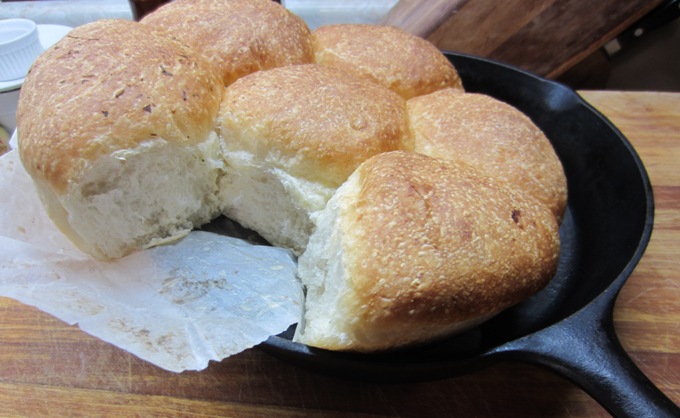As regular readers will know, I’ve sworn off most all bread from the local factory bakers. Try as they might, they can’t afford to invest the time that makes bread taste great. My everyday oat bread has gotten a lot of attention lately it seems and so I thought I best share my even quicker method for ‘pull apart’ buns since I make them just as regularly. I think of them as ‘mini loaves’ fit for countless roles (ha! get it?) in my menus.
I can split them to make quick little sandwiches of cheese and tomato, slip a crispy pan-fried fish fillet in between the halves with some spicy homemade mayo for a more substantial bite, or chase pan gravy around the rim of the roasting tray with them. Served warm on the side of any plate with garlic and honey butter or spread with marmalade and clotted cream for tea, their texture fits anywhere. I think it’s just the right crust-to-tender-insides ratio from the rise and bake in a heavy iron skillet that makes them so flexible. That skillet makes for an oven-inside-an-oven which adds another layer of certainty to the results.
If the harvest gods demand using up abundant fresh herbs from the garden or windowsill, they can get folded into the fairly sturdy dough easily. A quick roll and fold in cinnamon sugar can take them an entirely opposite direction. I’ve even added tiny cubes of mozzarella and pepperoni for dipping into tomato sauce after in a fit of pizza bun experimentation and can confirm that spicy chorizo sausage and Gruyere will in fact live side by side happily when wrapped in a bun. When you have a good bread base, you can get pretty creative in the added flavour department but for the record, they’re just as good made ‘plain’ and warm from the oven with a touch of butter.
And when I say quicker, I really mean it. They take about five minutes hands on time if you use a machine but barely more than that if you’ve gone totally manual labour in your kitchen. They don’t knead or rise as long but the results in the last bazillion batches I’ve made are consistently good no matter what oddities I lump into them. The dough is a bit stiffer and forming irregularities are more than eclipsed by a final rise in my trusty old cast iron skillet which nestles them perfectly. Specific times will be down to your pan dimensions and ambient kitchen temperature but the dough will speak to you when it’s ready to pop into the oven.
Everyday Pull-Apart Buns
Depending on your pan size, you may end up with an extra bun (or three) that won’t fit in with room to spare. Don’t try to shoehorn surplus into place if you want fluffy results. Park spares in another small pan or on a bit of foil (which will bake a few minutes quicker) and eat fresh from the oven as a baker’s perk.
500 grams bread (high-gluten) flour *
2 teaspoons rapid rise dry yeast
300 ml warm water @ 45C (~115F)
1 teaspoon fine sea salt
1 teaspoon sugar
1 tablespoon olive oil
3 tablespoons unsalted butter, melted
Optional additions:
50 grams shredded firm cheese (e.g. cheddar)
2 – 3 tablespoons fresh herbs, finely minced (e.g. rosemary, sage, etc.)
2 – 3 tablespoons of cinnamon sugar mixed to preference
50 grams cured sausage, finely diced
With modification to rising and bake times, super cheese with up to 200g of 1cm (1/2inch) diced cheese and/or pepperoni. Video of that mayhem can be found here.
Yield: Eight generous rolls or ten slightly smaller versions to preference
* By all reports, Canadian all-purpose flour has a bit more protein content than some international counterparts thanks to our hard wheat crop so you may need to substitute a small portion of “strong” or bread flour to get the structure you desire out of your pantry.
Place the flour and yeast into the bowl of an upright mixer fitted with a dough hook or your favourite large manual mixing basin. Dissolve the salt and sugar into the warm water and stir into the flour mix along with the oil and half the butter. Stir further by hand to combine into a shaggy dough and then knead by hand or machine until a ball forms, about a minute. Rest for a minute then continue to knead five minutes longer. If using herbs or other additions, add them in the last minute of kneading. Place in an oiled bowl covered loosely to rise until double in size, about an hour in a warm undisturbed place. On cold Canadian mornings I use a closed oven warmed briefly to take off the chill.
Divide the dough into 8-10 portions and form each into balls using a cupped hand on a dry work surface. Line the bottom of a cast iron skillet or similar with parchment and place the balls with roughly an inch or two between each. Cover loosely with a kitchen towel and allow to rise fully so that the rolls touch and pillow above the rim of the skillet slightly, about another hour.
Halfway through the final rise, preheat the oven fully to 235C (450F).
Brush the tops of the buns gently with remaining melted butter being careful not to deflate them. Bake for five minutes. Rotate the pan and reduce the heat to 205C (400F) for a further fifteen to twenty minutes until an internal temperature of 95C (205F) is reached. Allow to cool in the pan on a rack for ten minutes then remove to serve warm or cool completely before sealing in a plastic bag for up to three days.
-msh v.2.3

